Artisan: Hand-applied technique simulating cracks, worm holes, carved or worn edges, screw marks, chisel marks and dings to create the impression of naturally aged wood.
Beveled Panel: A panel that is shaped at an angle.
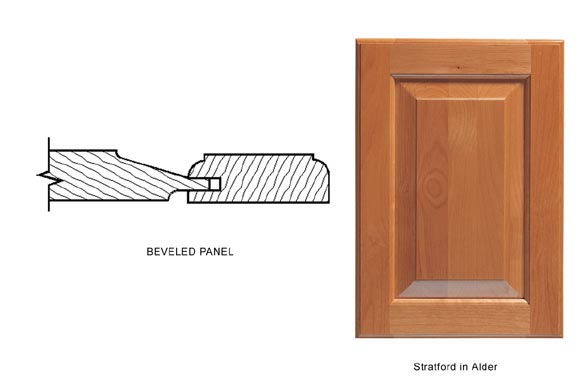
Burl: A swirl or twist in the wood grain that is caused by any number of natural factors that include: knot location, genetic components or naturally occurring damage to the bark.
Caramelizing: Occurs in Maple that has been heated to a high temperature, causing its sugars to turn a brownish color.
Closed (also Sound) Knot: Has a flat face without an opening in the wood surface.
Concave Panel: The surface is curved or rounded inward.
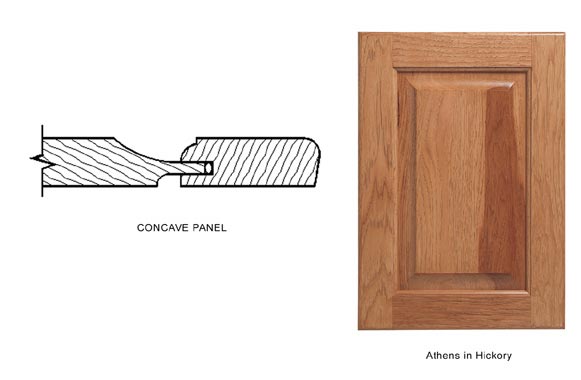
Convex Panel: The surface is curved or rounded outward.
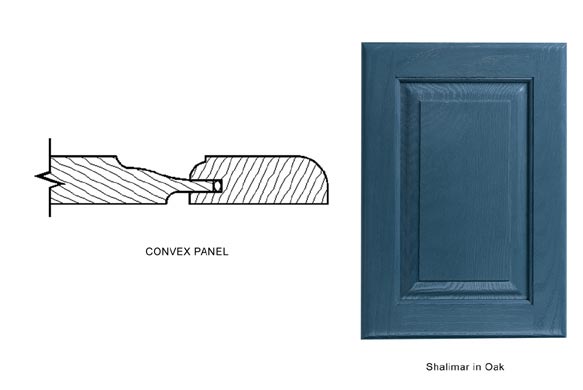
Distressing: A hand-applied process of creating random nicks and cuts in the wood surface to create a well used, or aged look. These random marks are applied to all finished areas except the back of door and drawer fronts and on small mouldings.
Dovetail: A fan-shaped tenon that when fitted into a corresponding mortise forms a tight interlocking joint. Known for their strength and durability, dovetail drawers are examples of high-quality drawer construction.
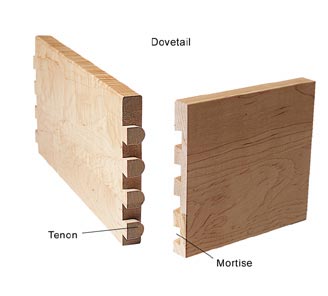
Edge Banding: Any strip of material that is applied to the edge of a panel to seal or finish the edge. Also known as edge tape.
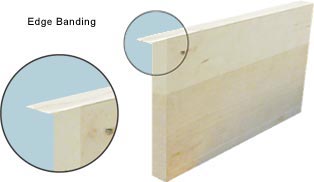
Edge Detail: Describes the profile of the door or drawer front. Edge details include notched, rounded, and square edges.
Finial Hinge: A hinging option used with Inset cabinetry, which is decorative and semi-concealed.
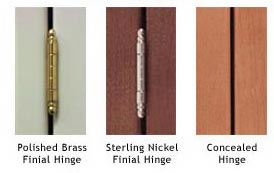
Framed Construction: Cabinet construction with face frames to which the cabinet doors are attached. The face frame has horizontal rails and vertical stiles.
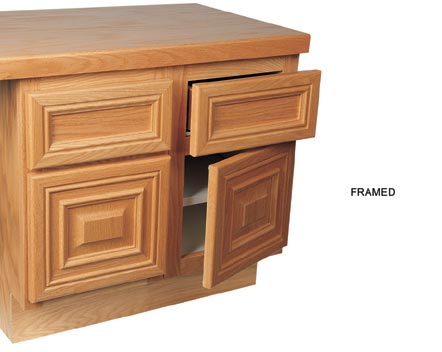
Frameless Construction: Cabinet construction in which the hinges are secured to the inside of the cabinet, and the doors overlay the cabinet box, minimizing the space between the doors when closed.
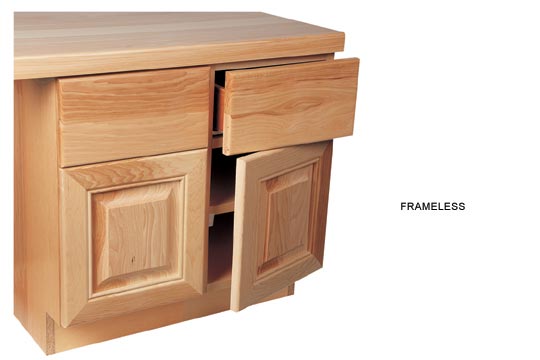
Full-extension: Style of guide that allows a drawer to open to the full depth, giving easy access to items in the back of the drawer.
Glazing: A specialty finish in which a material is applied after the stain and seal coat, and then hand wiped to create an aged or antiqued look that is unique to each piece. Glazing is applied to the entire surface, and shows well on surfaces with sharp crevices or edge details, distress marks, and woods with an open grain such as Hickory or Oak.
Heartwood: The central core of wood in a tree that no longer produces sap and tends to be dark in color.
Heartwood Stain: A build-up of extractives that cause the heartwood to be much darker in some trees. Heartwood stains are brownish to blackish in color.
Highlighting: A finish option in which material is applied to detailed areas of wood-paneled doors, fronts and profiled mouldings. Highlighting is applied to specific areas rather than the entire surface, resulting in a more refined look than Glazing.
Inset Construction: Cabinet construction in which the cabinet door and drawer fronts are recessed (inset) and flush with the cabinet face frame.
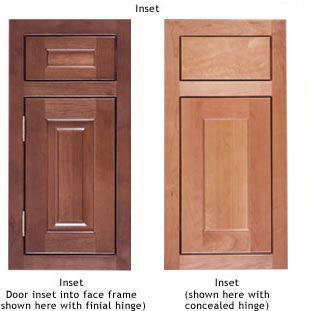
Island: A free-standing work surface often placed in the center of the kitchen. With the addition of furniture legs, feet, finished panels, and a contrasting finish, the center island can become an interesting focal point anchoring the design of the kitchen.
Laminate: Family of products in which a finish material is fused to a substrate. Laminates include LPL (Low-Pressure Laminate) and HPL (High-Pressure Laminate). HPL is thicker, stronger and more durable.
MDF: Stands for "medium density fiberboard." MDF is an engineered wood made from compressed and bonded wood fibers. MDF is very dense and stable, allowing for very fine tolerances when machined, and is used as a substrate for some sheet goods and doors.
Mineral Streak: Naturally occuring wood areas caused by minerals extracted from the soil. The streaks appear as blackish-blue, well-defined and run parallel with the grain, and are not considered a defect.
Mitered: Corners are fitted together with the ends of two parts cut at 45 degrees and joined together to form a 90-degree turn.
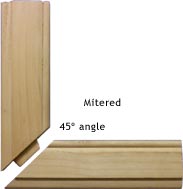
Modified Overlay: Uses a door with a larger overlay to allow a smaller amount of the face frame to be visible. The door overlays the face frame by 1-1/4 inch, side-to-side and 1/2 inch top-to-bottom.
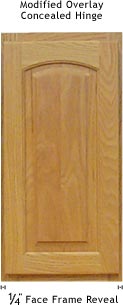
Mortise & Tenon: The joining of two pieces of wood where a notch or hole has been cut into one wood piece to receive a corresponding projecting part from another wood piece.

Moulding: An ornamental strip used as a finishing touch to decorate a surface.
Open Knot: Knots with open areas on the surface of the wood.
Peninsula: A counter-height section of cabinetry that extends from the wall into the room, often at a 90 degree angle. Peninsulas may include a cooktop, sink, or snack bar, and help separate the kitchen space from other adjoining rooms without using a solid wall.
Pin Knot: Knots that are small and tight on the surface of the wood.
Rail: Horizontal framing pieces of the cabinet face frame or door assembly. Supported on either side by stiles.
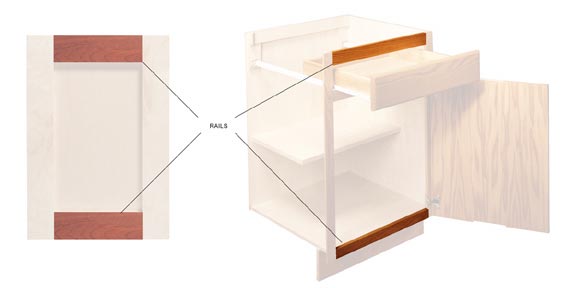
Ray Flecks: Rays, or strips of cells, store food and transport it horizontally throughout the tree. Naturally occuring ray flecks appear as lines across the grain of the wood surface.
Sapwood: Sapwood appears lighter in color than the heartwood (center of tree).
Soffit: The area above the top edge of wall cabinets to the ceiling.
Spattering: Small specks of color are randomly sprayed onto finished areas to create an antiqued look.
Stile: Vertical framing pieces of the cabinet face frame or door assembly. Supports the rails.
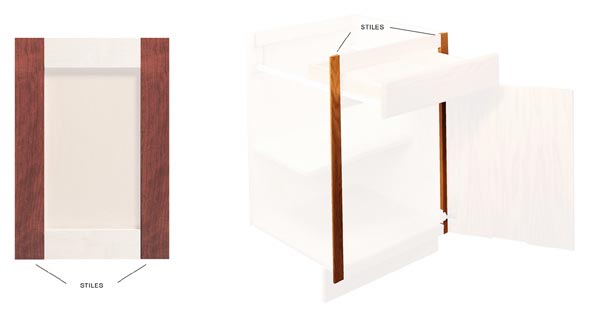
Substrate: The material used as a base for Laminates, Thermofoils and Veneers.
Thermofoil: Made of rigid, vinyl foil that is vacuumed and bladder pressed with a bonding adhesive onto a routered MDF substrate.
Traditional Overlay: Uses a door with a minimal overlay to allow a larger amount of the face frame to be visible. The door overlays the face frame by 1/2 inch side-to-side and 1/2 inch top-to-bottom.
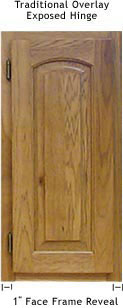
Undermount: A guide that is attached to the bottom of a drawer instead of the side, giving a much cleaner look when the drawer is extended.
Veneer: A fine layer of wood adhered to the face of a substrate.